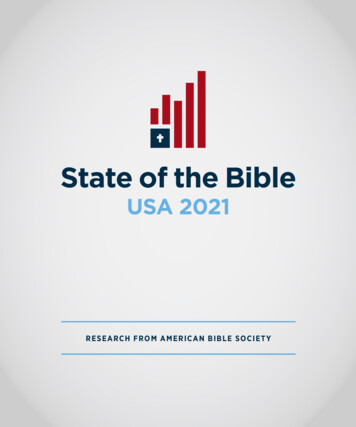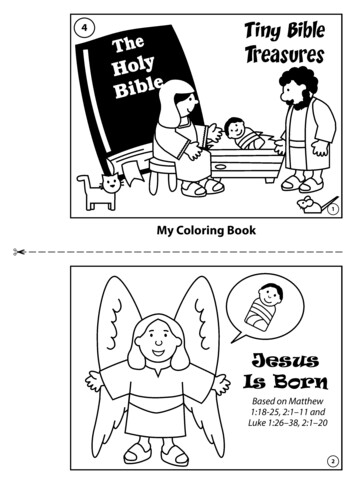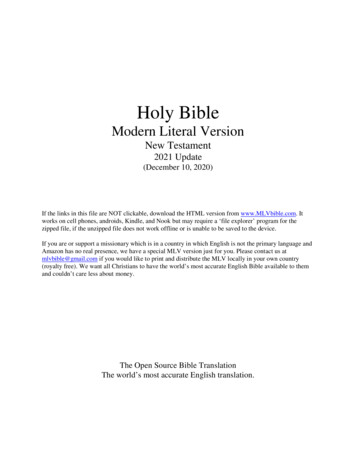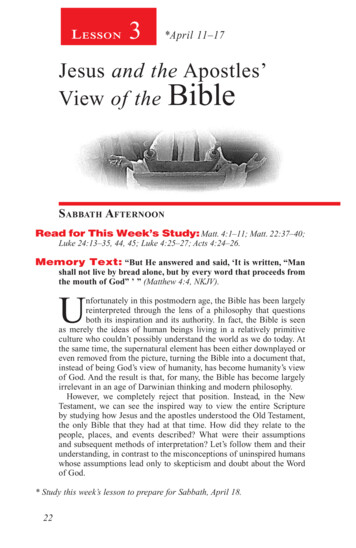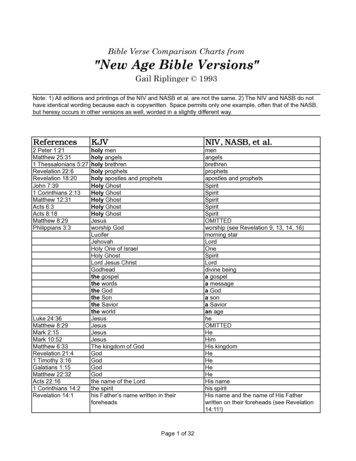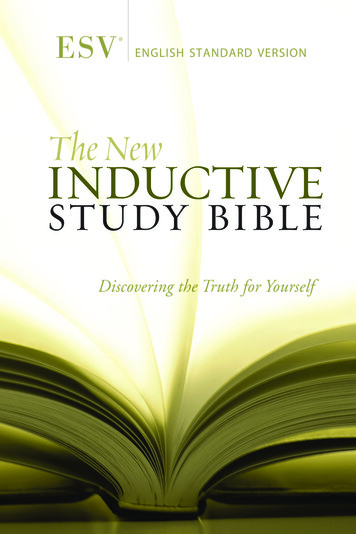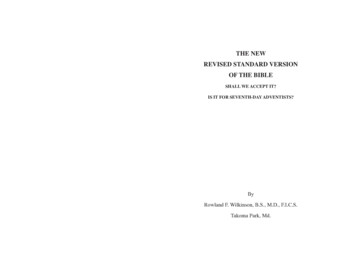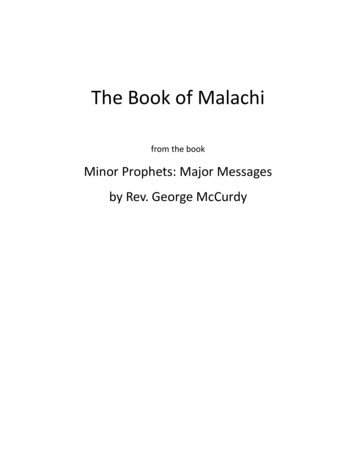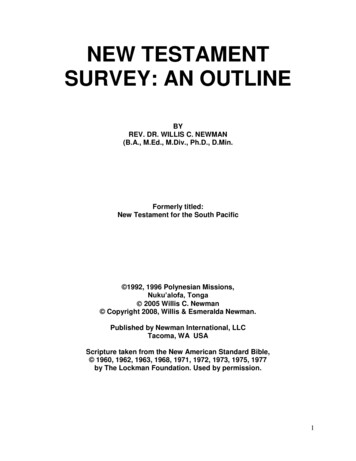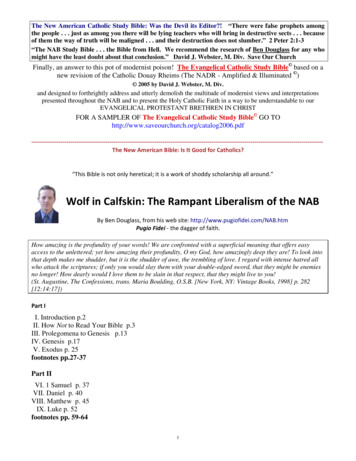
Transcription
The New American Catholic Study Bible: Was the Devil its Editor?! “There were false prophets amongthe people . . . just as among you there will be lying teachers who will bring in destructive sects . . . becauseof them the way of truth will be maligned . . . and their destruction does not slumber.” 2 Peter 2:1-3“The NAB Study Bible . . . the Bible from Hell. We recommend the research of Ben Douglass for any whomight have the least doubt about that conclusion.” David J. Webster, M. Div. Save Our ChurchFinally, an answer to this pot of modernist poison! The Evangelical Catholic Study Bible based on anew revision of the Catholic Douay Rheims (The NADR - Amplified & Illuminated ) 2005 by David J. Webster, M. Div.and designed to forthrightly address and utterly demolish the multitude of modernist views and interpretationspresented throughout the NAB and to present the Holy Catholic Faith in a way to be understandable to ourEVANGELICAL PROTESTANT BRETHREN IN CHRISTFOR A SAMPLER OF The Evangelical Catholic Study Bible GO �‐‐‐‐‐‐‐‐‐‐‐‐‐‐The New American Bible: Is It Good for Catholics?“This Bible is not only heretical; it is a work of shoddy scholarship all around.”Wolf in Calfskin: The Rampant Liberalism of the NABBy Ben Douglass, from his web site: http://www.pugiofidei.com/NAB.htmPugio Fidei ‐ the dagger of faith.How amazing is the profundity of your words! We are confronted with a superficial meaning that offers easyaccess to the unlettered; yet how amazing their profundity, O my God, how amazingly deep they are! To look intothat depth makes me shudder, but it is the shudder of awe, the trembling of love. I regard with intense hatred allwho attack the scriptures; if only you would slay them with your double-edged sword, that they might be enemiesno longer! How dearly would I love them to be slain in that respect, that they might live to you!(St. Augustine, The Confessions, trans. Maria Boulding, O.S.B. [New York, NY: Vintage Books, 1998] p. 282[12:14:17])Part II. Introduction p.2II. How Not to Read Your Bible p.3III. Prolegomena to Genesis p.13IV. Genesis p.17V. Exodus p. 25footnotes pp.27-37Part IIVI. 1 Samuel p. 37VII. Daniel p. 40VIII. Matthew p. 45IX. Luke p. 52footnotes pp. 59-641
AbbreviationsSJNAB: Saint Joseph Edition of the New American Bible (New York, NY: Catholic Book PublishingCo., 1992).DeRev: Vatican I Dogmatic Constitution Dei Filius, Ch. 2, De Revelatione (April 24, 1870).PD: Leo XIII, Providentissimus Deus (November 18, 1893).LS: St. Pius X, Lamentabili Sane (July 3, 1907).PDG: St. Pius X, Pascendi Dominici Gregis (September 8, 1907).SP: Benedict XV, Spiritus Paraclitus (September 15, 1920).HG: Pius XII, Humani Generis (August 12, 1950).HOT: Fr. George Leo Haydock, The Douay-Rheims Old Testament (Monrovia, CA: Catholic Treasures,1992).HNT: Fr. George Leo Haydock, The Douay-Rheims New Testament (Monrovia, CA: Catholic Treasures,1991).CCHS: Dom Bernard Orchard, O.S.B., ed., A Catholic Commentary on Holy Scripture (London:Thomas Nelson and Sons, 1953).KD: C. F. Keil and F. Delitzsch, Commentary on the Old Testament, 10 Vols. (Peabody, MA:Hendrickson, 2006; Repr. 1866-1891).ANF: Philip Shaff, ed., Ante-Nicene Fathers (Grand Rapids, MI: Eerdmans, 2001).NPNF: Philip Shaff, ed., Nicene and Post-Nicene Fathers (New York, NY: Christian LiteraturePublishing Co., 1893).PART II. IntroductionHoly Mother Church understands that false doctrine is the more dangerous to the extent that it ispresented under "a form of godliness" (cf. 2 Tim 3:5). This is why, for instance, every Pope who reignedduring the 19th century condemned Protestant "biblical societies." The putative aim of these societieswas to promote knowledge of the Word of God by publishing and circulating free copies of the Bible inthe various vernacular languages: certainly, in itself, a noble cause. Yet, under the godly bound form ofa volume of the Sacred Scriptures, they delivered to unsuspecting Catholics erroneous translations of thesacred page which might harm their Catholic faith. Leo XII warned, "There are good reasons for fearthat (as has already happened in some of their commentaries and in other respects by a distortedinterpretation of Christ's gospel) they will produce a gospel of men, or what is worse, a gospel of thedevil!"1 Pius VIII said of these societies that, "They skillfully distort the meaning by their owninterpretation. Furthermore, the Bibles are rarely without perverse little inserts to insure that the reader2
imbibes their lethal poison instead of the saving water of salvation."2 Gregory XVI, with perhaps morecharity, stated, "In the many translations from the biblical societies, serious errors are easily inserted bythe great number of translators, either through ignorance or deception."3 Bl. Pope Pius IX accused thesocieties of "perverse explanations."4 In their versions, the biblical text was "subverted and mostdaringly twisted to yield a vile meaning."5 Lastly, Leo XIII confirmed that the versions published by thebiblical societies were dangerous and forbidden to Catholics.6It is the thesis of this article that the above papal condemnations apply in spades to one particularbiblical society, and one particular biblical version, which are flourishing in our day: namely, TheCatholic Biblical Association of America and its New American Bible, or NAB.7 J'accuse: the NAB, inmany places, daringly redacts, rearranges, or otherwise mistranslates the sacred text, and it does so in theservice of the modernist critical hermeneutic which is revealed in its "perverse" introductions andcommentary. These comments repeatedly contradict or call into question the Catholic dogma of theplenary inspiration and inerrancy of Sacred Scripture8 as also the Catholic dogmas of Christology andMariology. The NAB refuses Scripture the submission which is due to it according to the Catholicsaints: "Holy Scripture is in such sort the rule of the Christian faith that we are obliged by every kind ofobligation to believe most exactly all that it contains, and not to believe anything which may be ever solittle contrary to it."9 Indeed, it freely confesses that Scripture is wrong in places and freely disagrees.The NAB charges the Bible with contradiction, concerning which Oecumenius may be quoted asrepresentative of the faith of the whole world: "For nothing could be contradictory in the mouth of theone and the same Spirit."10 Yet more, the NAB would have our Lord in ignorance and our Lady in doubtof her faith, which can only eventuate in Catholic readers doubting theirs. This Bible is a danger to thefaith of Catholics; it is a near occasion for sin.11And, tragically, the New American Bible is clothed in a form of godliness far more convincing thananything that a Protestant biblical society could ever hope to weave. Indeed, it possesses all thetrappings of a faithfully Catholic Bible. It boasts three imprimaturs,12 an apostolic blessing from PopePaul VI,13 and the approval of the United States Conference of Catholic Bishops. The NAB is, in fact,the translation which must be used in all English language lectionaries in Catholic Churches in America(although there are differences between the printed NAB and the lectionary NAB). The NAB is hostedon the Vatican's website.14 And as icing on the cake, the St. Joseph Edition even contains a smattering ofattractive and traditional Catholic art: David slaying Goliath, Elijah ascending into heaven, the fifteenoriginal mysteries of the Holy Rosary, the Stations of the Cross, etc. For a cherry on top, it dutifullyinforms the reader he may earn a plenary indulgence by reading Sacred Scripture for one half hour.In sum, every external appearance leads the reader, Catholic or non-Catholic, to assume that this Biblerepresents authentic Catholic teaching. This being the case, Catholics will give this Bible to theirchildren, trusting that their Church guarantees that it is safe, and inquiring Protestants, Jews, andAtheists will take its commentary as representative of how the Catholic Church understands SacredScripture. How tragic, then, when the Catholic child loses his faith, when the Protestant discovers thatthe Catholic Church believes the Bible is full of errors, when the Jew realizes that the largest Christiandenomination admits that the New Testament misrepresents the Old, when the Atheist is confirmed inhis suspicion that scholarly Christians do not mean what they say when they call the Bible the Word ofGod, and when all of them reject the mystical body of Christ.The purpose of this study is to prevent such loss of souls by exposing the wolf beneath the calfskin ofthe NAB, and by sounding the alarm against it.15 This Bible does not represent authentic Catholicism. Itis not "the faith which was once for all handed down to the saints" (Jude 1:3). It is poison. To Catholics Isay, "do not trust this Bible"; to non-Catholics, "please do not reject the Catholic Church on its account";to the bishops, "protect your flock from this thing."3
With loving confidence in their intercession, I place this study under the patronage of St. Joseph, St.Paul, St. Jerome, St. Augustine, St. Pius X, and Mary, Destroyer of Heresies.II. How Not to Read Your BibleThe Catholic Books Publishing Company has added a guide entitled "How to Read your Bible" to thefront matter of the St. Joseph Edition of the NAB. This guide, it is acknowledged,16 "has been adaptedby John Kersten, S.V.D., from his book Understanding Hebrew Literature." While this guide is not partof the NAB proper, and hence not the object of any official episcopal approbation, it is neverthelessintegrated seamlessly with such "official" front matter as the apostolic blessing of Paul VI and thePreface to the Old Testament, thus creating the appearance that all those imposing statements ofecclesiastical approbation to be found just inside the front cover apply in fact to it.17 For this reason, aswell as its wide dissemination among the simple faithful and the sheer audacity with which itdeconstructs the traditional Catholic doctrine of biblical inspiration, "How to Read Your Bible" merits tobe vigorously refuted.As with currency, so with doctrine: the best way to learn to recognize fraud is to familiarize oneself withthe genuine article. As such, before proceeding to critique "How to Read Your Bible," it will be helpfulto briefly review the Catholic doctrine of biblical inspiration as it is expounded in the authentic sources.St. Paul declares in 1 Timothy 3:16 that "all Scripture is inspired by God," or, in Greek (partially), "allScripture is theopneustos": literally, God-breathed. Scripture is the breath or speech of God in humanform. Put another way, that which we read in Scripture is spoken to us by God (Matthew 22:31). Thisbeing the case, God's action in biblical inspiration is analogous to the Incarnation of Jesus Christ. "For asthe substantial Word of God became like to men in all things, 'except sin' (Heb 4:15), so the words ofGod, expressed in human language, are made like to human speech in every respect, except error."18Therefore, the First Vatican Council properly (and dogmatically) defines inspiration as divine"dictation."19 Leo XIII elaborates on the First Vatican Council's decree:This supernatural revelation, according to the belief of the universal Church, is contained both inunwritten Tradition, and in written Books, which are therefore called sacred and canonical because,"being written under the inspiration of the Holy Ghost, they have God for their author and as such havebeen delivered to the Church." This belief has been perpetually held and professed by the Church inregard to the Books of both Testaments; and there are well-known documents of the gravest kind,coming down to us from the earliest times, which proclaim that God, Who spoke first by the Prophets,then by His own mouth, and lastly by the Apostles, composed also the Canonical Scriptures, and thatthese are His own oracles and words - a Letter, written by our heavenly Father, and transmitted by thesacred writers to the human race in its pilgrimage so far from its heavenly country. [S]uch and so greatis the excellence and the dignity of the Scriptures, that God Himself has composed them.20The Pope goes on to describe the mechanism of biblical inspiration, the process by which God causedthe sacred authors to write His words:[B]y supernatural power, [The Holy Ghost] so moved and impelled [the sacred authors] to write - Hewas so present to them - that the things which He ordered, and those only, they first rightly understood,then willed faithfully to write down, and finally expressed in apt words and with infallible truth.Otherwise, it could not be said that He was the Author of the entire Scripture. Such has always been thepersuasion of the Fathers. "Therefore," says St. Augustine, "since they wrote the things which Heshowed and uttered to them, it cannot be pretended that He is not the writer; for His members executedwhat their Head dictated." And St. Gregory the Great thus pronounces: "Most superfluous it is to inquire4
who wrote these things-we loyally believe the Holy Ghost to be the Author of the book. He wrote itWho dictated it for writing; He wrote it Who inspired its execution."21Truly, Peter has spoken through Leo, for this is the same doctrine of biblical inspiration which is taughtby St. Peter himself. "Men carried by the Holy Spirit spoke from God" (2 Peter 1:21).Needless to say, the doctrine expounded by Kersten in "How to Read Your Bible" is a far cry from thisdoctrine of the Church. Kersten relates inspiration to a process of mutual influence whereby culturalsensitivities "inspire" gifted members of that culture to create, who thereby render those culturalsensitivities more acute still. He draws an analogy from the production of jazz music: the Negrocommunities are especially sensitive to music and rhythm, leading them to produce such august figuresas Louis Armstrong, Duke Ellington, and Ray Charles, and these in turn have further heightened themusical and rhythmic sensitivities of the Negro community and indeed of the entire world. "More or lessby this same process of mutual influence Hebrew literature came into being," Kersten declares.We see in the Hebrew people a highly developed sensitivity for God's presence in their lives. From thesepious Hebrew communities we see arise prophets, preachers, writers, who offered their (first spoken)reflections on that shared experience of God's presence with His people. In turn these prophets,preachers and writers heightened that religious sensitivity in their people.22Operating under such a sub-Catholic definition of inspiration, Kersten has difficulty distinguishing theinspiration of Scripture from the inspiration of jazz.23 To be sure, he insists that Hebrew literature "isinspired (breathed upon) in a very special way by almighty God." But, before he can proceed to definewhat exactly is "special" about biblical inspiration as opposed to ordinary artistic inspiration, he mustfirst insist at length upon what biblical inspiration is not:This does not mean that God dictated His message as a businessman dictates a letter to a secretary. Godtakes the author as he is and leaves him free to choose his own means of communication. Isaiah was agreat poet and composed beautiful poems to convey his message. Ezekiel was not well-versed in lettersand his language is rather poor. Some authors chose existing folktales and even beast fables to bring outtheir point.24It is true that God did not dictate His message to the sacred authors in the same manner that abusinessman dictates a letter to a secretary. "God chose men and while employed by Him they made useof their powers and abilities, so that with Him acting in them and through them, they, as true authors,consigned to writing everything and only those things which He wanted."25 Nevertheless, God's methodof communication is properly described as dictation, as seen above. Anyway, Kersten finally getsaround to positively defining his own position with the laconic statement, "Inspiration is guidance." Hefleshes out this statement in the next section:God Himself guided (inspired) the Hebrew genius in its searching out of the mysteries of the humancondition. When this restless searching for truth and meaning culminates in unfolding one of God'smysteries, we speak of divine revelation. This means that God reveals some aspect of Himself or thehuman condition in and through man's endeavors to find out. Hence, "everything in the Bible is inspired,but not everything is revealed" (Pierre Benoit).26So it seems that, for Kersten, that which distinguishes biblical inspiration from ordinary artisticinspiration (apart from subject matter) is simply the occasional tap on the shoulder or tug on the wristfrom God. The composition of Scripture is, then, in this view, an essentially human activity, with Godmerely coaxing it along like a parent teaching a child to ride a bicycle.5
This position is thoroughly unacceptable. In order to consistently maintain this view, one must deny thatGod is the primary author of any part of Scripture, and moreover must deny that God is in any sense theauthor of those parts of Scripture where the Hebrews got things quite wrong, as Kersten will soon assertthey did (after all, if a parent is coaxing a child properly, he is not responsible when the child falls offthe bicycle anyway). This in spite of the solemn insistence of both Vatican Councils that God is theprimary author of the books of Scripture "in their entirety, with all their parts."27Furthermore, this guide fails to recognize that much of revealed truth is wholly inaccessible to humansearching, even searching which is performed in a spirit of prayer and in docility to the ordinaryoperations of grace. As such, human searching for truth and meaning can never "culminate in unfoldingone of God's mysteries." God does not reveal supernatural truths "in and through man's endeavors tofind out," if this is understood in the sense that God merely directs a properly human activity until thisactivity attains to revealed truth. This is a Pelagian and Rationalist conception of revelation. On thecontrary, man receives revelation passively, ex auditu, that is, by hearing (cf. Rom 10:17).Finally, while Kersten's definition may suffice to distinguish biblical inspiration from the inspiration ofjazz, it fails to adequately distinguish between Sacred Scripture and any pious work of literaturecomposed in a spirit of prayer and inquisitiveness. If "inspiration is guidance," as Kersten asserts, why isit then that Zephaniah is in the Bible whereas St. Thomas' Summa is not? Let's move on.Sometimes inspired searching for meaning leads to conclusions which cannot be qualified as revelationfrom God. Think of the "holy wars" of total destruction, fought by the Hebrews when they invadedPalestine. The search for meaning in those wars centuries later was inspired, but the conclusions whichattributed all those atrocities to the command of God were imperfect and provisional. See Judges 1:18.28While I understand Kersten's "sensitivity," his solution to the difficulty of biblical violence is, like hisdefinition of inspiration, thoroughly unacceptable. Not only does it stand condemned by theMagisterium, which has condemned the position that the Bible contains errors except as regards faithand morals,29 and thus has condemned a fortiori the position that the Bible contains errors even asregards faith and morals. Simply on a rational level, this position creates far more problems than itsolves. Kersten would have us believe that the wars which the Bible plainly states were commanded byGod were not in fact commanded by God, but rather were crimes against humanity perpetrated byHebrew murderers. Then, centuries later, their descendants attempted to justify the crimes of theirforefathers by ascribing said wars to the command of a deity. Perhaps it did not dawn on John Kersten,S.V.D., that justifying murder by ascribing it to the command of a deity is a moral abomination. Indeed,it is the moral equivalent of Nazi apologetics. This being the case, it is difficult to see how anyone couldmaintain that a holy God could have any part whatsoever in "inspiring" this activity. No, logic andconscience will not admit this possibility. It would be far more consistent and moral to simply denybiblical inspiration outright.An additional difficulty with this position is that it opens the pandora's box of enabling men todistinguish within Scripture, on the one hand, divine revelation, and on the other hand, immoral humaninventions. If this principle be admitted, what is to stop men from rejecting the Bible's condemnation of,say, homosexuality, as Luke Timothy Johnson does, for example?30 Indeed, once one relativizes theauthority of Scripture in principle, one turns the Bible into a cafeteria from whose various offerings oneis free to pick and choose, based on some subjective criterion, to believe or not to believe. Hence, onemay accept that part of the Bible where it says that God is love and the nice story where Jesus forgivesthe woman at the well, but reject the biblical teachings that sodomy and fornication are sins and thatwives must be obedient to their husbands. Immense numbers of souls have surely been lost because theyhave done exactly that. The Catholic doctrine of inspiration and inerrancy, on the other hand, is a firm6
foundation: it safeguards the totality of revelation from those who would like to do away with its lessthan popular teachings.Finally, Catholic tradition has already (long since, in fact) supplied us with a simple and satisfyingsolution to the problem of biblical violence which obviates Kersten's attempted solution. Murder is theunjust slaying of a man. Not all killing, however, is unjust. A soldier may justly kill enemy soldiers in ajust war, and a state may justly execute criminals, for example. Similarly, no one kills unjustly who killsat the explicit command of God, who is Justice itself.31 God is the sovereign Lord of life and death, Whoordains both the time and the means of death for every living man, good or evil. He inflicts His universalsentence of death by whatever means should suit His purposes; and indeed, as the Bible records, He hason occasion chosen the ministrations of His angels or the armies of His chosen people. As St. ThomasAquinas taught, God "inflicts the punishment of death on all men, both godly and ungodly, on accountof the sin of our first parent, and if a man be the executor of that sentence by Divine authority, he will beno murderer any more than God would be."32Moving on, in the next section, Kersten offers us a piece of advice with which, in other contexts, Iwould wholeheartedly agree: "Therefore read the introductions to the Bible books and pay attention tothe footnotes!"33 In the present context, however, this advice is suited only to knowledgeable Catholicswho are unlikely to be scandalized and who intend a proportionate good.Next, Kersten makes a number of highly objectionable statements concerning the story of the Garden ofEden. These insinuate, at best, that the narrative surrounding Adam and Eve is fictitious, and at worst,that Adam and Eve are fictitious themselves. To be sure, true to Modernist form he does not assert hisposition plainly; he conveys his meaning rather through the techniques of the English gentlewoman:Lady Marchmain was not diffuse, but she took hold of her subject in a feminine, flirtatious way,circling, approaching, retreating, feinting; she hovered over it like a butterfly; she played 'grandmother'ssteps' with it, getting nearer the real point imperceptibly while one's back was turned, standing rootedwhen she was observed.34Nevertheless, I think I have succeeded in catching his meaning. He states the following in the section ofthe guide on literary forms:b) The Allegory: A figure story with a veiled meaning. Read Genesis 2, 3, 4:1-16, 6-8, 11, 19. Forcenturies these chapters have been misunderstood as inspired lessons in science. The Bible does notteach science; it teaches religious values. It uses these folktales to teach a lesson. Again, the point of theallegory (not the details) is God's message to you.35Later, he adds:Most scientists hold that the human species has developed somehow from lower kinds of life. Thisknowledge helped Christians to understand that Genesis 2 and 3 is not a lesson in Anthropology, but anallegory, teaching us the lesson that sin is the root of all evil. You may hear interpreters of the Biblewho are literalists or fundamentalists. They explain the Bible according to the letter: Eve really ate fromthe apple.36The mere fact that Kersten has identified the Garden of Eden as an allegory is cause for alarm. Anallegory, in the technical sense, is a purely metaphorical narrative.37 This definition is conformable toKersten's, if not coextensive, and it implies that the whole story of the Garden is fictional. Furthermore,the reason Kersten stresses the word "veiled" in his definition of allegory is because this is whatdistinguishes it from the first genre which he defines, namely, the parable, "A short fictitious narrative7
from which a moral or spiritual truth is drawn."38 If, then, a parable is a fictitious narrative from which alesson is explicitly drawn, an allegory is a fictitious narrative which contains a lesson for the discerningreader.Next, if, as Kersten says, Genesis 2 and 3 do not teach Anthropology, then they do not teach the originof the first man and first woman. Thus the story is divested of one of its fundamental truths. And if thelesson of the story is merely that sin is the root of all evil, generically speaking, rather than that onespecific, historical sin, is the root of all evil, then the story is further divested of the dogma of OriginalSin. I submit therefore that Kersten's position stands condemned by the Council of Trent:If anyone does not confess that the first man, Adam, when he transgressed the commandment of God inparadise, immediately lost the holiness and justice in which he had been constituted, and through theoffense of that prevarication incurred the wrath and indignation of god, and thus death with which Godhad previously threatened him, and, together with death, captivity under his power who thenceforth hadthe empire of death, that is to say, the devil, and that the entire Adam through that offense ofprevarication was changed in body and soul for the worse, let him be anathema.39Clearly, the Catholic dogma of Original Sin depends wholly and completely on the substantialhistoricity of the story of the Garden of Eden, and it was in terms of this story that the dogma wasdefined. If the Garden of Eden is a mere allegory then this dogma is a house built on sand.Because of this, the Magisterium has, twice during the last century, solemnly reaffirmed that the Gardenof Eden is historical. First, in 1909 the Pontifical Biblical Commission, which St. Pius X had investedwith papal authority,40 decreed that it could not be taught that the first three chapters of Genesis were nottrue in the literal historical sense. Moreover, the Commission emphasized especially that the literalhistorical sense could not be impugned regarding Adam's transgression of the divine commandment"through the devil's persuasion under the guise of a serpent," their motivation for doing so being toprotect the integrity of the dogma of Original Sin.41 Second, in 1950 Pope Pius XII issued an encyclicalentitled Humani Generis which denounces the ideas that Adam and Eve were not real, individual people,that there has ever existed any true human who was not descended from them, and that the first 11chapters of Genesis are not history in a true sense.42 He, likewise, saw the historicity of the Garden ofEden as being essential to the integrity of the dogma of Original Sin.With that, let us return to Kersten. Does he confess that "Adam. transgressed the commandment of Godin paradise"? At the very least, he does not confess that Eve ate from the apple, and he assigns the wholestory to a fictitious literary genre. Because of this, I am under the impression that he does not.In the next section, Kersten offers an ambiguous assertion which could easily be read as charging theBible with scientific error. He states, "The ancient Hebrews saw the earth as a large plate with a hugevault over it. Above the vault is God's place. This outlook conditioned Genesis 1."43If it were true that the Bible contains scientific errors, as Kersten here seems to intimate, and as the NABwill enunciate more clearly in the commentary proper, this would be destructive of the credibility ofChristianity, and St. Augustine might as well have remained a Manichee. For St. Augustine knew that ifan author claimed to speak with the voice of God, but was caught in error in testable assertions of fact,then his claim to divine inspiration would be invalidated, and hence one could never trust his untestableassertions about religion. Thus Augustine was ultimately able to see through the pretensions of Mani:It was providential that this man talked so much about scientific subjects, and got it wrong, because thisgave people who had truly studied them the chance to convict him of error; and then by implication hisinsight into other, more recondite matters could be clearly assessed. Mani was content with no modest8
evaluation: he tried to persuade his followers that the Holy Spirit. was with full authority present in himpersonally. It followed, therefore, that when he was caught out in untrue statements about the sky andthe stars, or the changes in sun or moon, his presumption was plainly revealed as sacrilegious, becausealthough these matters ar
Title: The New American Bible: Is It Good for Catholics
